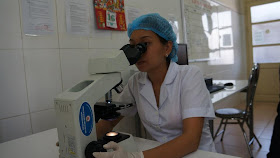Mice with different naturally occurring stomach bacteria have distinct susceptibilities to disease caused by Helicobacter pylori, the well-known cause of ulcers in humans, according to a study published online ahead of print in the journal Infection and Immunity. This is the first study to document (in mice) that the presence of certain bacteria in the stomach microbiota can prevent pathology from H. pylori.
Read more at:
http://medicalxpress.com/news/2013-03-stomach-microbiota-modulate-resistance-pylori-driven.html#jCp
Mice with different naturally occurring stomach bacteria have distinct susceptibilities to disease caused by Helicobacter pylori, the well-known cause of ulcers in humans, according to a study published online ahead of print in the journal Infection and Immunity. This is the first study to document (in mice) that the presence of certain bacteria in the stomach microbiota can prevent pathology from H. pylori.
Read more at:
http://medicalxpress.com/news/2013-03-stomach-microbiota-modulate-resistance-pylori-driven.html#jCp
Mice with different naturally occurring stomach bacteria have distinct susceptibilities to disease caused by Helicobacter pylori, the well-known cause of ulcers in humans, according to a study published online ahead of print in the journal Infection and Immunity. This is the first study to document (in mice) that the presence of certain bacteria in the stomach microbiota can prevent pathology from H. pylori.
Mice with different naturally occurring stomach bacteria have distinct susceptibilities to disease caused by Helicobacter pylori, the well-known cause of ulcers in humans, according to a study published online ahead of print in the journal Infection and Immunity. This is the first study to document (in mice) that the presence of certain bacteria in the stomach microbiota can prevent pathology from H. pylori.
Read more at:
http://medicalxpress.com/news/2013-03-stomach-microbiota-modulate-resistance-pylori-driven.html#jCp
Mice with different naturally occurring stomach bacteria have distinct susceptibilities to disease caused by Helicobacter pylori, the well-known cause of ulcers in humans, according to a study published online ahead of print in the journal Infection and Immunity. This is the first study to document (in mice) that the presence of certain bacteria in the stomach microbiota can prevent pathology from H. pylori.
Read more at:
http://medicalxpress.com/news/2013-03-stomach-microbiota-modulate-resistance-pylori-driven.html#jCp
Mice with different naturally occurring stomach bacteria have distinct susceptibilities to disease caused by Helicobacter pylori, the well-known cause of ulcers in humans, according to a study published online ahead of print in the journal Infection and Immunity. This is the first study to document (in mice) that the presence of certain bacteria in the stomach microbiota can prevent pathology from H. pylori.
Read more at:
http://medicalxpress.com/news/2013-03-stomach-microbiota-modulate-resistance-pylori-driven.html#jCp
Read more:
Other stomach microbiota modulate resistance to H. pylori-driven ulcers
Source: Medical Xpress
Art and Science of Laboratory Medicine
Mice with different naturally occurring stomach bacteria have distinct susceptibilities to disease caused by Helicobacter pylori, the well-known cause of ulcers in humans, according to a study published online ahead of print in the journal Infection and Immunity. This is the first study to document (in mice) that the presence of certain bacteria in the stomach microbiota can prevent pathology from H. pylori.
Read more at:
http://medicalxpress.com/news/2013-03-stomach-microbiota-modulate-resistance-pylori-driven.html#jCp

















































